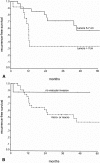Long-term results with multimodal adjuvant therapy and liver transplantation for the treatment of hepatocellular carcinomas larger than 5 centimeters
- PMID: 11923610
- PMCID: PMC1422469
- DOI: 10.1097/00000658-200204000-00012
Long-term results with multimodal adjuvant therapy and liver transplantation for the treatment of hepatocellular carcinomas larger than 5 centimeters
Abstract
Objective: To determine the long-term results of liver transplantation for hepatocellular carcinoma (HCC) measuring 5 cm or larger treated in a multimodality adjuvant protocol.
Summary background data: Transplant has been established as a viable treatment of HCC measuring less than 5 cm, but the results for larger tumors have been disappointing. Several studies have shown promising preliminary results when combining transplant with preoperative transarterial chemoembolization and/or perioperative systemic chemotherapy in the treatment of advanced HCC that is not amenable to resection. However, follow-up in the studies has been limited and the number of patients has been small.
Methods: Beginning in October 1991, all patients with unresectable HCC measuring 5 cm or larger, as measured by computed tomography, were considered for enrollment in the authors' multimodality protocol. Entry criteria required that all patients be free of extrahepatic disease based on computed tomography scans of the chest and abdomen and bone scan and have a patent main portal vein and major hepatic veins on duplex ultrasonography. Patients received subselective arterial chemoembolization with mitomycin C, doxorubicin, and cisplatin at the time of diagnosis, repeated as necessary based on tumor response. Patients received a single systemic intraoperative dose of doxorubicin (10 mg/m(2)) before revascularization of the new liver and systemic doxorubicin (50 mg/m(2)) every 3 weeks as tolerated, for a total of six cycles, beginning on the sixth postoperative week.
Results: Eighty patients were enrolled; 37 were eventually excluded, due mainly to disease progression while on the waiting list, and 43 underwent liver transplant. Mean pathologic tumor diameter was 5.8 +/- 2.7 cm. Median follow-up of surviving transplanted patients was 55.1 +/- 24.9 months. There were two (4.7%) perioperative deaths. Median overall survival was significantly longer in transplanted patients (49.9 +/- 10.42 months) than in those who were excluded (6.83 +/- 1.34 months). Overall and recurrence-free survival rates in transplanted patients at 5 years were 44% and 48%, respectively. A tumor size larger than 7 cm and the presence of vascular invasion correlated significantly with recurrence. Recurrence-free survival at 5 years was significantly higher for the 32 patients with tumors measuring 5 to 7 cm (55%) than the 12 patients with tumors larger than 7 cm (34%).
Conclusions: A significant proportion of patients with HCC measuring 5 cm or larger can achieve long-term survival after liver transplantation in the context of multimodal adjuvant therapy. Patients with tumors measuring 5 to 7 cm have significantly longer recurrence-free survival compared with those with larger tumors.
Figures



Similar articles
-
Long-term outcomes of hepatocellular carcinoma that underwent chemoembolization for bridging or downstaging.World J Gastroenterol. 2019 Oct 7;25(37):5687-5701. doi: 10.3748/wjg.v25.i37.5687. World J Gastroenterol. 2019. PMID: 31602168 Free PMC article.
-
[Influence of treatment of hepatocellular carcinoma before liver transplantation on post transplant tumor recurrence and survival].Gastroenterol Hepatol. 2010 Mar;33(3):155-64. doi: 10.1016/j.gastrohep.2009.10.001. Epub 2009 Nov 30. Gastroenterol Hepatol. 2010. PMID: 19945770 Spanish.
-
A multidisciplinary approach to hepatocellular carcinoma in patients with cirrhosis.J Am Coll Surg. 1995 May;180(5):596-603. J Am Coll Surg. 1995. PMID: 7749537
-
Risk factors, prevention, and management of postoperative recurrence after resection of hepatocellular carcinoma.Ann Surg. 2000 Jul;232(1):10-24. doi: 10.1097/00000658-200007000-00003. Ann Surg. 2000. PMID: 10862190 Free PMC article. Review.
-
Treatment before liver transplantation for HCC.Ann Surg Oncol. 2008 Apr;15(4):993-1000. doi: 10.1245/s10434-007-9787-8. Epub 2008 Jan 31. Ann Surg Oncol. 2008. PMID: 18236111 Review.
Cited by
-
The Degree of Lipiodol Accumulation Can Be an Indicator of Successful Treatment for Unresectable Hepatocellular Carcinoma (HCC) Patients - in the Case of Transcatheter Arterial Chemoembolization (TACE) and External Beam Radiotherapy (EBRT).J Cancer. 2016 Jul 4;7(11):1413-20. doi: 10.7150/jca.15405. eCollection 2016. J Cancer. 2016. PMID: 27471557 Free PMC article.
-
Living donor liver transplantation for adult patients with hepatocellular carcinoma: experience in Japan.Ann Surg. 2004 Sep;240(3):451-9; discussion 459-61. doi: 10.1097/01.sla.0000137129.98894.42. Ann Surg. 2004. PMID: 15319716 Free PMC article.
-
Surgical treatment of hepatocellular carcinoma: expert consensus statement.HPB (Oxford). 2010 Jun;12(5):302-10. doi: 10.1111/j.1477-2574.2010.00182.x. HPB (Oxford). 2010. PMID: 20590903 Free PMC article. Review.
-
Management of Hepatocellular Carcinoma Recurrence after Liver Transplantation.Cancers (Basel). 2021 Sep 29;13(19):4882. doi: 10.3390/cancers13194882. Cancers (Basel). 2021. PMID: 34638365 Free PMC article. Review.
-
Nomogram predicting pulmonary metastasis of hepatocellular carcinoma after liver transplantation.Oncotarget. 2017 Dec 19;9(2):2425-2434. doi: 10.18632/oncotarget.23418. eCollection 2018 Jan 5. Oncotarget. 2017. PMID: 29416782 Free PMC article.
References
-
- Fan ST, Lai EC, Lo CM, et al. Hospital mortality of major hepatectomy for hepatocellular carcinoma associated with cirrhosis. Arch Surg 1995; 130: 198–203. - PubMed
-
- El-Serag HB, Mason AC. Rising incidence of hepatocellular carcinoma in the United States. N Engl J Med 1999; 340: 745–750. - PubMed
-
- Tsuzuki T, Sugoika A, Ueda M, et al. Hepatic resection for hepatocellular carcinoma. Surgery 1990; 107: 511–520. - PubMed
-
- Mazzaferro V, Regalia E, Doci R, et al. Liver transplantation for the treatment of small hepatocellular carcinoma in patients with cirrhosis. N Engl J Med 1996; 334: 693–699. - PubMed
Publication types
MeSH terms
Substances
LinkOut - more resources
Full Text Sources
Medical

